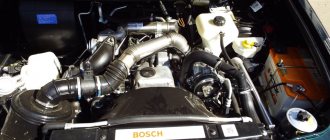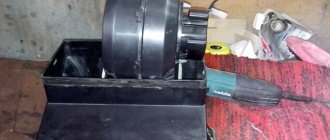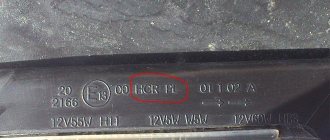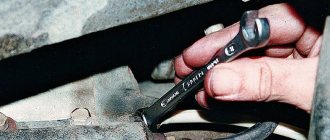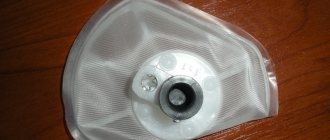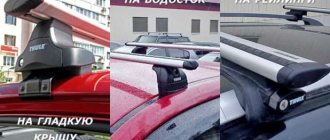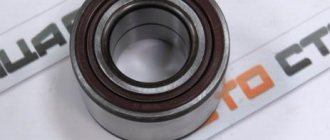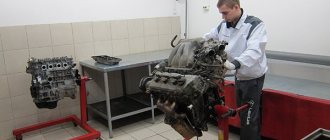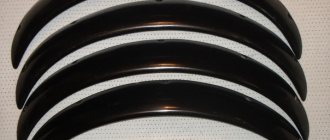Valve mechanism design - operating principle and possible malfunctions
Valves are used to seal engine cylinders during gas exchange.
The principle of their operation is to ensure the intake of a mixture of fuel and air for its further compression. After ignition and exhaustion, the gases enter the exhaust system, and valves are also responsible for this. This mechanism operates in the aggressive conditions of an internal combustion engine and is constantly subjected to high dynamic loads, high speeds and heat. To reduce the rapid wear of the running parts of this part, the manufacturing materials most often have a high degree of alloying with nickel and chromium. The valve mechanism has two main components: the head and the stem. These car components come with a tulip-shaped, flat and convex head. At the end of the rod there are conical, shaped or cylindrical grooves for fixing springs on them. The main manifestation of a valve mechanism malfunction is a loss of engine power, as well as unstable operation of the engine as a whole. Failures of this type occur due to sticking and the appearance of a gap. Carbon deposits can also cause this problem; it accumulates near the valve itself and prevents it from closing.
Another sign of a malfunction is increased smoke emission during exhaust. A worn rod and guide of this mechanism will cause unnatural engine noise.
Need for replacement
On all cars, the repair principle is the same, just like replacing valves on a VAZ Priora can be done with your own hands.
The main sign of malfunctioning valves is a decrease in compression. This mainly happens for three reasons.
The first is burnout. This happens like this: the valve plates are destroyed or cracks appear in them, subsequently, at any position of the camshaft, the combustion chamber is depressurized.
Exhaust valves are mainly affected by this, because they are subject to a large thermal load.
In most of these situations, it is necessary to replace the valve seats, which is difficult to do with your own hands, since they will need to be pressed out and then pressed into place.
This problem may occur due to:
- incorrectly adjusted thermal gap, this applies to engines without a hydraulic compensator;
- a very lean mixture, this increases the temperature in the combustion chamber;
- The timing phases are not properly adjusted, which is why a fire is created during the period when the valve does not fit tightly to the seat. This can also contribute to the formation of carbon deposits in places where parts come into contact;
- a manufacturing defect;
- engine detonation for any reason.
The second is the bending of the valves as a result of a collision with the pistons. This is only possible if the timing belt breaks or jumps; the jump occurs due to a stretched belt or chain.
The third is rod wear. In the operating mode of the engine, the valves move along the guide bushings; during prolonged use, the rod wears out.
In this case, an excessive gap occurs between the inner walls of the bushings and the valve stems, which negatively affects the operation of the valve mechanism.
In this case, you will have to replace not only the valves, but also the guide bushings, which you can also do yourself.
Symptoms of a problem
The cause of unstable engine operation caused by loss of power, compression in any cylinder and vibration can be not only the valves.
If the timing belt breaks, it is not a fact that the valves will bend; the pushers more often break off. Even with the help of a compression gauge, you can only make sure that there is no compression in the cylinders, but you will not be able to find out the reason.
You can add a small amount of engine oil to the cylinder, but if the compression increases, the reason is the wear of the piston group.
To more accurately determine the diagnosis of the engine, it is better to conduct a test with a pneumatic tester.
What to use?
Such work involves the use of rough tools that are characterized by almost jeweler precision - countersinks and cutters. Such tools with narrow specifications are used exclusively for engine repairs.
A selection of cutters for valve seats is used for recessing the required diameter sizes. Such actions make it possible to give the plate maximum closing density.
Countersinks are used in the same way when repairing valve seats. But there is one difference - the countersink is used not only on mechanical, but also on power tools.
Tool
If we are replacing valves with our own hands, be it a VAZ or another car, we must not miss such a nuance as the presence of a special tool. Here's what you'll need:
Sets: wrenches, sockets, screwdrivers for dismantling and installing machine elements.
Valve desiccant. It is needed to compress the springs in order to eliminate the cracks (locking elements).
This is interesting: Why does the muffler shoot: a list of reasons for popping noises in car operation
Lapping tool. The valves require lapping to ensure compression. Purchasing a special device is not advisable; you can use a drill and a piece of hose.
The hose tightly connects the valve stem and the drill attachment and grinds in with translational movements. Then pour diesel fuel at the junction of the valve and the seat; if it does not leak, then the job is done efficiently.
Tool for removing oil seals. When replacing valves, you need to change the caps on the bushings, which will be quite difficult to do with your own hands. It is better to use a special puller.
Using improvised tools can cause damage to the integrity of the part, which will lead to the need to purchase new seals.
There is another device - a micrometer. It will give an accurate measurement of the rod parameter and identify valve wear defects.
A key for fixing the crankshaft in order to adjust the correct operation of the timing belt.
It is advisable to have a torque wrench to tighten the bolts.
Consumables
In addition to valves, you will need:
- suitable sealing caps;
- cylinder head gasket;
- valve cover gasket;
- if necessary, sealant;
- cylinder head mounting bolts, sometimes it is possible to use old bolts;
- lapping paste or powder.
Countersinks and cutters for repairing valve seats – what to choose?
Replacing valve seats with your own hands requires the presence of not only a rough tool, but also an almost jewelry one - a roller cutter or a countersink. These highly specialized tools are used only for repairing internal combustion engines. A set of cutters for valve seats is used to grind out the desired shape of their internal diameter . This operation allows you to achieve a tight seal from the plate. In order to accurately process the valve seat, it is advisable to have a drawing of the mechanism at hand.
The cutter is made in the form of a metal cylinder, in which there is a hole and two or one conical surface; its angle can vary from 15 to 60 degrees. There are incisors on the surface of the cone. A set of countersinks for repairing valve seats is used in the same way as cutters, but there is one difference. The countersink can be used on mechanical and electrical tools.
Valve seat blank
For all popular engines, valve seat blanks are offered, both standard sizes and repair ones, with an increased outer diameter. For rare engines, blanks must be ordered or made to order.
Such blanks are quite cheap; if you don’t find one for a certain motor, you can choose the size from the available items. But don’t forget that companies that produce engine parts (Kolbenschmidt), in particular valves, also produce seats of the same sizes, so ask in stores in your city. After installation, the seat will need to be processed - chamfered for the valve.
Replacing the VAZ valve seat
The valve seat is an important part of the cylinder head design; this can be easily verified by examining the operation of the valve and its components.
The most important function that the seat performs is to form a strong compression between itself and the valve. Thanks to this, gas leakage from the combustion chamber is minimized; good thermal contact between the valve and the seat are necessary conditions for this.
In other words, the tight fit between the parts allows heat to be removed from the plate with maximum efficiency, transferring heat from the valve through the seat to the cylinder head, which in turn is cooled by the liquid. During engine operation, the chamfers and seats wear out, which leads to defective valve seats. When depressurization occurs, the heat transfer order of the plate and seat is disrupted, which provokes defects and destruction of parts.
Under such conditions, the issue of maintaining the tightness of the connection comes to the fore. This can be achieved mainly only by forming the necessary profile for the valve seat and chamfer, which will balance the wear of the surfaces of the parts.
Replacing valve seats with your own hands - we analyze the specifics of the work
This operation is performed in two ways. The first one is rough, but the simplest and fastest. It is carried out quite primitively: an old valve is welded onto a worn seat ring, and then the ring is simply knocked out with a hammer from its regular place in the cylinder head; by the way, it can be damaged, which is very undesirable. Next comes the process of pressing in the new one. The soft method is much more complicated, however, it can be done in your garage without the intervention of expensive equipment. The saddle in this method is carefully turned on a machine. After this, the seat is cleaned and also ground.
Execution technology
The work is complex, but if you have the necessary skills, it can be done in a garage.
There are several ways to remove the saddle. A quick, but not very correct method is to weld the valve onto the seat and then knock it out. The valve is ground to the size of the seat, inserted into it and scalded. Until the metal had time to cool. The saddle must be knocked out with a hammer. The entire structure should come out without any problems. But remember that welding heats up the metal, which can cause deformation of the head. By knocking it out, you can damage the seat under the saddle, which will entail additional work on processing the cylinder head. It is best to use a lathe. This way you can grind the saddle to such a size that it becomes like foil and can be easily taken out. If you don’t have a machine, you can use a drill and a cutter attachment. Stitching is carried out on one side until the tension weakens. The saddle can now be reached by hand.
The ideal option for installing a new seat is nitrogen, in which the seats should be pre-cooled. The fact is that their dimensions are slightly larger than the holes, and due to cooling the outer diameter decreases. Naturally, nitrogen in the garage is very rare. Then remember the properties of metal to expand and contract. The saddle is simply placed in the freezer for a couple of hours, and the hole is heated with a burner.
This is interesting: KIA Ceed lamps - replacing low and high beams with your own hands
If during installation it will be necessary to apply force, it is recommended to take a block suitable for the diameter of the seat and use it to press it.
Removing the seat
First, let's look at what not to do, although some automotive garage gurus recommend doing just that.
-valve welding + knocking out
First, the old unnecessary valve is adjusted to the dimensions of the seat, inserted onto the seat and the valve is welded to the seat. While it is still warm, knock out the valve and it comes out along with the seat. Due to the different expansion of metals - steel and aluminum - the tension decreases; when it cools down, it will not be so easy to come out.
Why shouldn't you do this? During welding, the entire head heats up and it will certainly move, it will become crooked and in addition to this, hidden cracks will open where there were internal stresses in the metal (and they exist in any case). Then you will wonder why my head suddenly turned out to be pierced.
The best way is to bore the valve seat on a machine until it becomes the size of foil and jumps out of the seat hole. But... this cannot be implemented in a garage due to the high cost of the equipment, and not every village will have such a machine. Therefore, let’s consider another method, easy and safe, and can be implemented in any garage.
Choosing garage technicians: a simple and safe way
Using a milling cutter, grind the saddle all the way through one edge. The seat will weaken, lose tension and jump out of the seating hole on its own, without even having to sharpen it through, reaching the seating plane, when a little less than 0.5 mm of tension remains, the tension is no longer enough to hold on. By opening the ring, the saddle will no longer be able to resist.
A drill cutter is sold in any hardware store and costs no more than a drill, which is why this method is so affordable.
Now that the saddle is out, we need to think about what we are going to put in there.
Stuffing the valve seals
But first you need to remove the old valve seals, on Zhiguli they must be removed carefully and in no case should you try to knock them off with a blow, the place where the seal is packed will break off, take pliers, hold the valve seal with them and try to turn it if it doesn’t work right away, grab it and try to turn it again, then grab it with the pliers and the valve seal will loosen and rotate and come out. Also remove the valve seals from the UAZ and GAZ.
And now we will fill the valve seals on the Zhiguli, insert the valve and put the valve seal on it up to the guide sleeve, take a tube with an internal diameter of 13 mm and carefully, with a light hammer, tap the valve seal with light blows, just do not overdo it, otherwise you will break the seal. If there is no such tube, you can flatten the larger tube a little to size, and saw the smaller one a little lengthwise and spread it to size. You can also first remove the spring from the valve seal so as not to accidentally damage it and then put it on the seal.
On UAZ and Gas, fill it in the same way as on Zhiguli, but the tube should have an internal diameter of 16mm.
Dry the valve
It was easy to remove the valve, but drying the valve without a valve remover is not very easy, but you can, put a piece of iron under the valve so that it rests on it, put on the springs, place a plate of springs on the springs and put crackers in it, take a 19 or 22 open-end wrench and firmly press on the springs and let your friend insert the crackers, this is all checked, I inserted the crackers into the valves like this several times.
Grinding the valve to the head
If the valve is burnt out, then the valve seat is also burnt out; usually mechanics first level the seat with a special cutter, which you don’t have; no, we can do without it (the engine has been tested and runs no worse). I’m amazed at how some motorists grind valves by hand (I’d go crazy) let an electric drill do the work for us (if you have a left-right reverse drill, it’s even better, but if not, this one will do). Spread the edge of the valve with rubbing powder, insert the valve into the head and clamp the end of the valve into the drill chuck, but not deeply, but to a depth of about 15 mm, the main thing is not to scratch the place where the valve comes into contact with the oil seal. Pull the valve up with a drill and turn it on, let the valve grind, make such movements up a little down and up again (I think you understand) if the drill is in reverse, switch the rotation. On a nine or eight, it is difficult to reach the valve with a drill; you need a very small chuck, but you can do this by taking a strong piece of reinforced rubber hose that fits very tightly onto the valve, take an 8mm pin and pull this piece of hose onto it as tightly as possible, clamp the pin into the drill and the other end hose onto the valve and also begin to grind the valve onto the head seat.
This is interesting: How much oil should be poured into the VAZ 2107 engine?
How to Replace a Valve Guide
In order to knock out the valve guide, you need a special mandrel, which you most likely don’t have, well, we don’t need to knock it out without it, take a round timber Ǿ12-13.5 millimeters or a long bolt Ǿ12mm for the Zhiguli head, for the UAZ and Gaza round timber Ǿ15-16mm or 16mm bolt. But there is a very important point on which I want to draw your attention, you need to knock out the guide sleeve from the inside towards the camshaft (from bottom to top) and it is very important to knock it out with a very heavy hammer with a half-hammer, the blow should not be very strong, the main thing is it must be heavy (the guide sleeve is easy will come out and won't crumble). If you start knocking out the valve bushing with a light hammer, the bushing will crumble and you will only suffer.
Installing a new saddle
Before starting the installation procedure of new saddles, the seats under them are cleaned of dirt. After the cylinder head should be heated evenly to a temperature exceeding 100˚C. At the same time, the metal expands, allowing the ring to be pressed in.
The mounted part is cooled using liquid nitrogen. In its absence, you can use a combination of ice and acetone, which allows you to reduce the temperature of the metal to -70˚C. The dimensions of the parts are selected in such a way that the difference between the diameter of the seat and the ring is no more than 0.05-0.09 mm on cold parts.
The valve seat is pressed into place using a special mandrel or a piece of pipe of suitable diameter. The part should fit into the seat with little effort. It is important that the ring fits without distortion.
After pressing in and cooling the cylinder head, you should check whether the element is loose in the seat. If there is no gap and the replaced element is held tightly in place, the replacement procedure can be considered complete. Next, you need to trim the valve seats using cutters.
Important! During the standard replacement procedure, the valve plates of all valves are set quite high. However, some experts recommend processing the chamfers so that the exhaust valves sit slightly deeper than the normal position. The intake valve seat is left in its normal position.
The valve seat must be installed correctly with nitrogen; all other methods are not as reliable. In normal condition at room temperature, the diameter of the seat is greater than the diameter of the hole in the head, so after installation some interference is obtained. To fit the saddle, it must be reduced in size, this is what nitrogen is needed for.
Liquid nitrogen retains a very low temperature. While cooling in nitrogen, the valve contracts in diameter, and when cooled it can freely fit into the mounting hole of the head. At the same time, to enlarge the mounting hole in the head, the head can be heated, then the hole will expand and the gap will increase. If you heat the head, then you don’t need to cool the saddle so much, it will be enough to just put it in the freezer and the temperature difference will be enough.
It is impossible to install the saddle without preliminary heat treatment; the required tension will not be achieved and the saddle will fall out during operation.
When installing, you need to hammer the saddle so that it falls into place, you don’t need to hit it hard, light blows are enough.
Machining a new seat
The newly installed seat must be chamfered. It is best to do this on a specialized machine, so it can be processed most accurately. This is achieved thanks to rigid centering of the cutter, which cannot be achieved using hand cutters.
But if there is no such equipment in your area, roller cutters are all you can count on. If there is a metalworking shop nearby, you can try processing the valves on a milling machine, the result will be fine.
On the seat you need to cut three edges - the outer, the inner and on top of them the central, narrowest one, along which the seat will come into contact with the valve.
Saddle repair
Repair of valve seats is carried out when they are naturally worn out and the disc does not fit tightly to its seat.
In order to restore the geometry of the rings, valve seat cutters are used - a set of milling heads that allow making the necessary angles.
Roller cutters can be used in combination with special equipment. However, it is expensive. Therefore, at home, a ratchet wrench with an extension is used. Properly treated areas have angles of 30˚, 60˚ and 45˚. The processing of valve seats to create each of them is carried out with the appropriate cutter.
Grinding valve seats does not require heating or other processing. Grooving is done “dry”. In the future, at the time of lapping, it is necessary to use a special lapping paste. To achieve the best result, it is recommended that lapping on new seats be done by hand rather than using a drill.
DETAILS: Instructions on how to change the oil in a BMW 5 Series E60 Do-it-yourself oil change in a BMW E60 engine
Another type of repair is the grooving of seats for repair inserts. To do this, according to the algorithm described above, the saddles are removed, after which the places for them are ground with a special cutting tool. The size of the repair area should be 0.01-0.02 cm smaller than the insert. Installation is carried out after heating the cylinder head and cooling the mounted elements.

